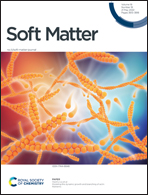Effect of network topology and crosslinker reactivity on microgel structure and ordering at liquid–liquid interface†
Abstract
Polymer microgels synthesized in silico were studied at a liquid–liquid interface via mesoscopic computer simulations and compared to microgels with ideal (diamond-like) structure. The effect of crosslinkers reactivity ratio on the single particle morphology at the interface and monolayer behavior was examined. It was demonstrated that single particles deform into an explicit core–corona morphology when adsorbed at the interface. An increase in the crosslinker reactivity ratio decreased both the deformation ratio and the ratio between the core and corona sizes. Meanwhile, the compression of microgel monolayers revealed the existence of five distinct interparticle contact regimes, which have been observed experimentally in the literature. The crosslinker reactivity ratio appeared to define the compression range in these regimes and the sharpness of the transition between them. In particular, the higher the crosslinker reactivity ratio, the smaller the corona, and in turn, the narrower the range of the intermediate regime comprising both core–core and corona–corona contacts. The obtained results demonstrate that the more realistic model of microgels synthesized via precipitation polymerization allows for a more accurate prediction of the properties of the microgels at a liquid–liquid interface in comparison to the conventional diamond-like lattice model.



 Please wait while we load your content...
Please wait while we load your content...